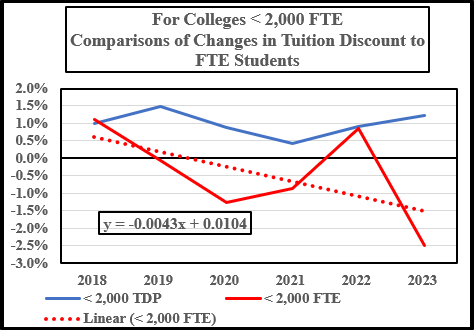by Michael K. Townsley | May 10, 2025 | Private Colleges & Universities in Crisis

If I is negative and between the range of 0 and – 5, then the college will be in a state of financial distress.
If C and E are negative then change sign of I to negative, regardless of the I score, the college will be in a state of deep financial distress.
by Michael K. Townsley | May 3, 2025 | Enrollment and Marketing
Has Tuition Discounting Run Its Course
For Private Colleges with Less than 2,000 FTE
The following chart shows that private colleges are no longer getting a positive return on tuition discounts because FTE enrollment exhibits a long-term negative trend in growth. Therefore, it is inefficient to continue increasing tuition discounts because they are not attracting more students. There are two unfortunate outcomes of decaying enrollments from ever-larger tuition discounts:
- Falling enrollments generate less tuition revenue.
- Rising tuition discounts yield smaller cash flows from each student.
This suggests that private colleges with fewer than 2,000 FTE must find a new strategy to increase revenue and cash flow. New strategies could include:
- New academic programs
- Partnerships with other colleges or local agencies
- Contracts with businesses,
- New athletic programs.
Alternative to revenue generating strategies to manage cash flow would be to:
- Cut costs
- Sell off unused property
- Consolidate offices and sell surplus buildings
- Kook for expense sharing with other colleges

As a small college faces financial distress, it is extremely difficult to afford new strategies. When a college is in deep financial distress, taking expeditious action is essential for survival.
by Michael K. Townsley | May 3, 2025 | Presidential Leadership, Uncategorized
Push and Pull-on Authority between President and Board of Trustees in a Financial Crisis
Presidents and boards of trustees often respond to a financial crisis with a destructive contest in which a board resists the president for greater authority. The president takes the lead because they believe that an effective response cannot take place unless they have more authority to make changes at all levels of the college. The board pulls back from the president’s request because they fears that the college will lose its historic identity and be unable to fulfill its mission.
Here are examples of the push-pull over authority between presidents and boards of trustees.
- The most obtuse case in the push-pull of authority is where the board does not include in its by-laws that it retains final authority over all decisions.
- A particularly annoying case for presidents is when a board prior to the crisis relinquishes its authority over academic programs and decisions on hiring, reassigning, and dismissing members of the faculty.
- For the president, the most troubling authority transfer to the faculty is when the board permits the faculty to determine the conditions for tenure, the number of tenure positions, and the procedures for reviewing tenure.
- Another short-sighted decision by a board is when they expand board membership to include members of the faculty. The ostensible reason given in some instances is to improve communications between the board and the faculty. Granting membership to the faculty for this reason is a clear statement that they do not trust the president. Problems with placing faculty on the board include:
- Faculty members are self-interested at a time when the board needs to be disinterested in the outcomes of its decisions.
- The faculty become privy to personnel action that may affect a member of a colleague.
- The faculty members could carry sensitive information about strategic options and personnel changes back to colleagues. Under these circumstances, a cautious board could forfeit open discussion.
- Even more debilitating is when a general uproar in the college results in leaks to the press. The danger with leaks to the press is that governmental agencies and accrediting bodies may become involved prematurely in options that are only under consideration.
- Disagreement between the board and president over the degree of authority to grant the president during a financial crisis may not be resolvable. Nevertheless, the board’s decision on granting additional authority can be critical, if the president has a credible strategy to end the financial crisis. Not granting the necessary authority can doom the possibility of stemming a financial crisis. In a deep financial crisis, time is of the essence.

